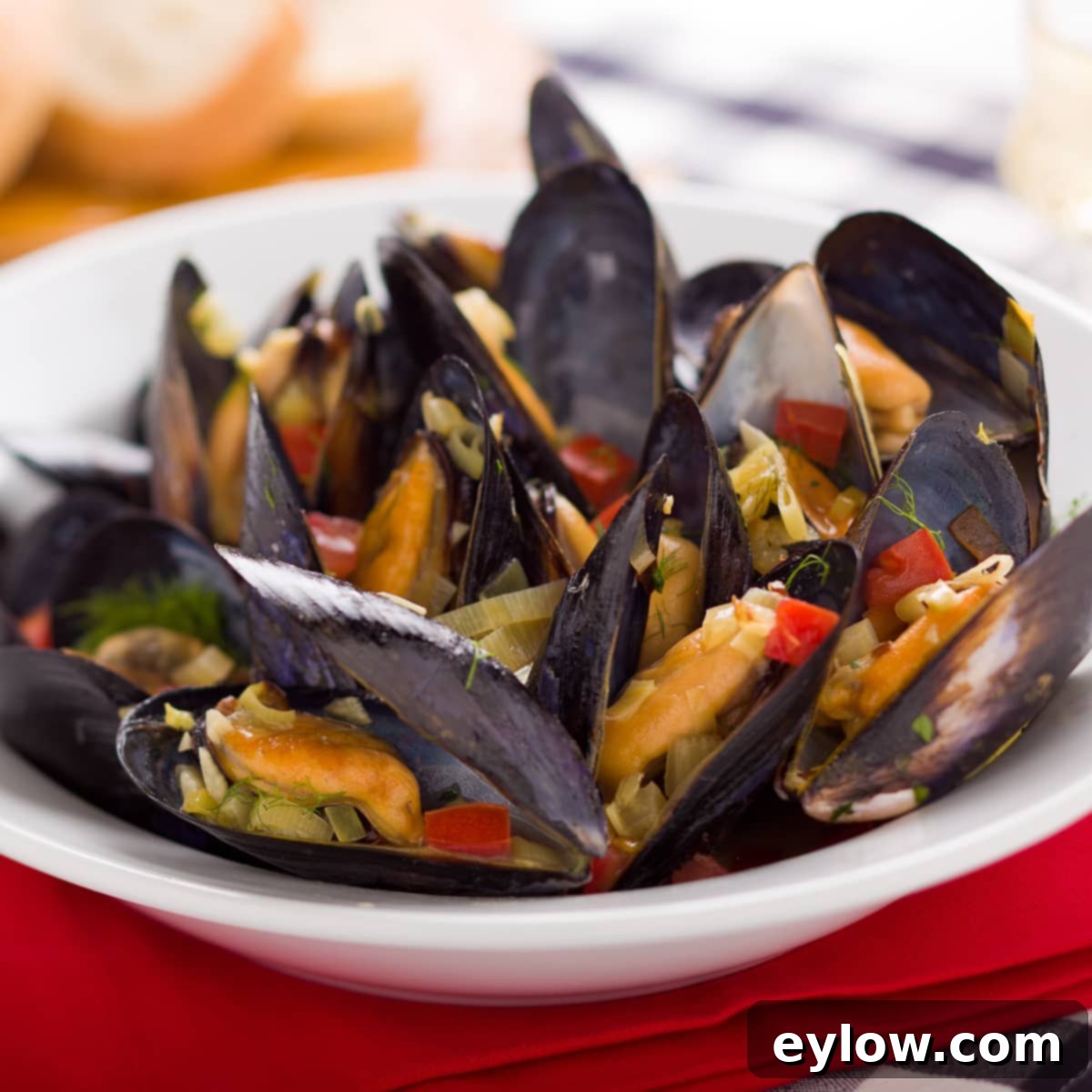Effortless Elegance: Mastering Steamed Mussels in White Wine (Moules Marinière) at Home
Steamed mussels in white wine, affectionately known by their French name, Moules Marinière, offer a culinary experience that perfectly balances sophistication with simplicity. This classic dish is incredibly versatile, serving as an easy yet impressive weeknight dinner or a delightful centerpiece for entertaining friends and family. Mussels themselves are a fantastic choice for seafood lovers: they are both inexpensive and packed with flavor, and perhaps best of all, they cook remarkably quickly. The magic truly happens when they open to reveal tender, succulent meat bathed in an aromatic, savory broth. Be sure to have a generous loaf of crusty bread on hand to sop up every last drop of the exquisite juices, and a soup spoon is essential – no one can resist savoring every bit of that flavorful liquid!
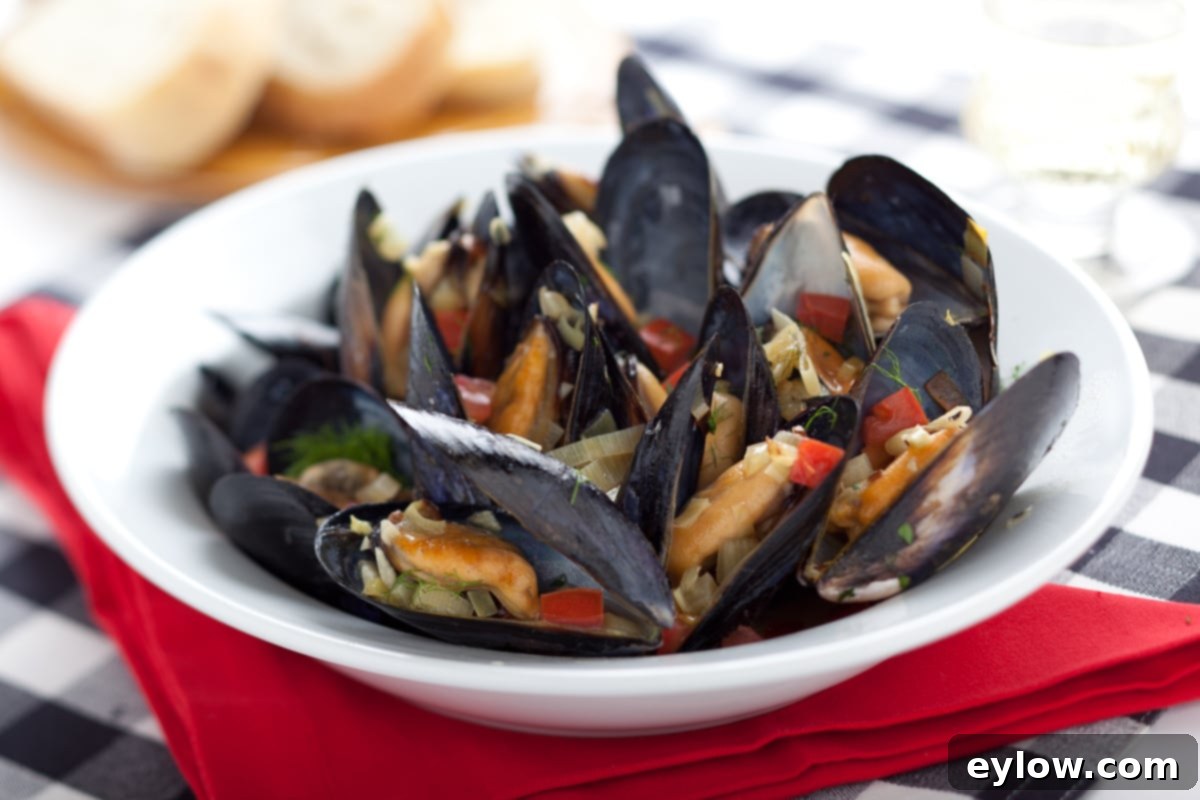
If you’ve only ever enjoyed these delectable mussels at a bustling bistro or a fine-dining establishment, now is the perfect moment to bring this gourmet delight into your own kitchen. Many home cooks are intimidated by preparing shellfish, but Moules Marinière is surprisingly straightforward. While traditional recipes often rely solely on white wine for their distinct flavor, I sometimes introduce a unique twist using Pernod, a famous French anise-flavored liqueur. This adds a subtle complexity and depth that elevates the broth. If you prefer to stick to the classic, feel free to omit the Pernod. For those curious to experiment, don’t feel obligated to purchase a large bottle; an airline-sized mini bottle from your local liquor store is perfect for a trial run.
Why Make Moules Marinière at Home?
There are numerous advantages to preparing steamed mussels yourself. Firstly, it’s significantly more cost-effective than ordering them at a restaurant. Mussels are one of the most affordable seafood options available, making this a luxurious meal that won’t break the bank. Secondly, the cooking process is incredibly fast, often taking less than 10 minutes once your ingredients are prepped. This makes it an ideal choice for busy weeknights when you crave something special without a lengthy cooking commitment. Beyond the practical benefits, there’s immense satisfaction in creating a dish that feels so indulgent. You control the quality of ingredients, the seasoning, and can easily customize it to your taste preferences, whether you prefer more garlic, a different herb, or a touch of spice.
The essence of Moules Marinière lies in its simplicity and the freshness of its ingredients. The broth, a fragrant blend of white wine, aromatics, and the natural juices released by the mussels, is the heart of the dish. It’s light, savory, and incredibly satisfying, perfectly complementing the sweet, briny flavor of the mussels. Preparing it at home allows you to enjoy this authentic French experience whenever the craving strikes, transporting you to the French coast with every spoonful.
Essential Ingredients for Perfect Steamed Mussels
To create this exquisite dish, you’ll generally need about a pound of fresh mussels per person if serving as a main course. Beyond the star ingredient, the supporting cast includes flavorful vegetables like crisp fennel, delicate leek, ripe tomatoes, and pungent garlic. The foundational liquid, of course, is a good quality dry white wine. For an intriguing variation, you can opt to cook with a blend of half white wine and half Pernod, as mentioned earlier, which imparts a wonderful anise note.
Exploring Pernod and Flavorful Substitutions
Pernod is a distinctive golden-colored French liqueur, first created in 1920, renowned for its lightly sweet licorice (anise) flavor. It’s a potent spirit, so when I incorporate it into my mussel broth, I typically use it in a 50/50 ratio with white wine. This ensures its unique flavor enhances the dish without overwhelming it. If Pernod isn’t readily available or you’re looking for alternatives with a similar aromatic profile, several liqueurs can serve as excellent substitutes. French Annisette or Pastis, Greek Ouzo, or Italian Sambuca all share comparable anise notes and can be used to achieve a similar depth of flavor.
For a completely non-alcoholic version: Don’t fret! You can still achieve a wonderfully flavorful broth. Substitute the wine and Pernod with a good quality vegetable broth. To replicate the acidity and brightness that wine provides, add a splash of fresh squeezed lemon juice just before serving. Another excellent non-alcoholic option is Verjus, an unfermented (and thus non-alcoholic) grape juice known for its tart, delicate flavor. It offers a sophisticated acidity that works beautifully in seafood dishes.
When selecting your white wine, choose a dry variety that you would enjoy drinking. Sauvignon Blanc, Pinot Grigio, or an un-oaked Chardonnay are all excellent choices. Avoid sweet wines, as they will alter the intended flavor of the broth. The wine’s acidity and fruit notes are crucial for balancing the richness of the mussels and the other aromatics.
Essential Kitchen Tools for Steaming Mussels
The most crucial piece of equipment for steaming mussels is a large pot with a tight-fitting lid. The size of your pot will directly determine how many mussels you can cook at once. If you’re preparing mussels for a larger group, say four people, and want to serve them all simultaneously, you’ll likely need two large pots to accommodate the volume. This ensures all mussels steam evenly and open properly. Attempting to overcrowd a single pot will result in uneven cooking and may prevent some mussels from opening.
For those with a very generously sized stockpot, perhaps a 12-quart capacity or larger, you might be able to cook all four pounds in one batch. The key is to have enough space for the mussels to steam without being completely submerged and for the steam to circulate effectively. A tight-fitting lid is equally important to trap the steam and create the perfect environment for the mussels to cook quickly and thoroughly.
Selecting the Freshest Mussels: A Guide
The success of your Moules Marinière hinges on the freshness of your mussels. When purchasing, always look for mussels that are closed tightly or that close themselves promptly when tapped. This indicates that they are alive and safe to eat. Avoid any mussels that are gaping open and do not close when handled, as these are likely dead and should be discarded. If a mussel feels unusually heavy for its size even when closed, it might be full of sand or mud and could also be dead. It’s a good practice to gently tap them and check their weight.
A reputable seafood counter typically sells mussels either loose in bins or in netted bags, always kept on ice. They should have a clean, fresh aroma reminiscent of the ocean, not a strong, fishy smell. Also, carefully inspect the shells. Do not buy mussels that have chipped, broken, or cracked shells, as their integrity may be compromised, leading to spoilage or the ingress of sand and grit. Trust your senses: if they don’t look, feel, or smell right, it’s best to pass.
Properly Storing Mussels for Optimal Freshness
Mussels are best cooked within a day of purchase to ensure peak freshness and flavor. Proper storage is crucial to keep them alive and healthy until you’re ready to cook. As soon as you bring them home, gently rinse them under cold running water to remove any loose dirt or debris. Then, transfer them to a large bowl. Fill the bowl halfway with ice – this keeps them cool and simulates their natural environment. Cover the mussels with damp paper towels or a clean kitchen towel. This prevents them from drying out while still allowing them to breathe. It’s vital not to leave mussels sealed in plastic bags or submerged in water, as this will suffocate them and cause them to die quickly. By following these simple storage guidelines, you’ll maximize their freshness and ensure a delicious meal.
Thoroughly Cleaning Mussels: The “De-Bearding” Process
Just before you’re ready to cook, give your mussels a final, thorough cleaning. Place the bowl of mussels in your sink and run cold water over them. Allow them to soak for approximately 20 minutes; this helps them expel any remaining sand from their interiors. After soaking, gently scrub each mussel with a stiff brush under cold running water to remove any grit, barnacles, or external debris clinging to their shells.
The next critical step is “de-bearding.” Mussels have a fibrous growth called a “beard” (byssal threads) that they use to attach themselves to rocks and other surfaces. While harmless, it’s unpleasant to eat, so it must be removed. To do this, firmly grasp the beard between your thumb and forefinger and pull it towards the hinge of the mussel with a sharp tug. If a beard is particularly stubborn, don’t hesitate to use a pair of small pliers to get a better grip. Discard any mussels that remain open after cleaning, or those with broken shells, as they are no longer suitable for consumption.
Preparing Your Aromatics: Chopping Fennel, Leeks, and Tomatoes
Efficient prep work is key to making this recipe flow smoothly. Before you even think about lighting the stove, chop all your vegetables for the broth and your herbs for garnish. This “mise en place” approach ensures a relaxed cooking experience.
To prepare your fennel, first, cut off the long, celery-like stalks from the bulb and discard them. However, save the delicate, fluffy fronds; these make a beautiful and flavorful garnish. Then, dice the fennel bulb into small, uniform pieces. Its subtle anise flavor will infuse beautifully into the broth.
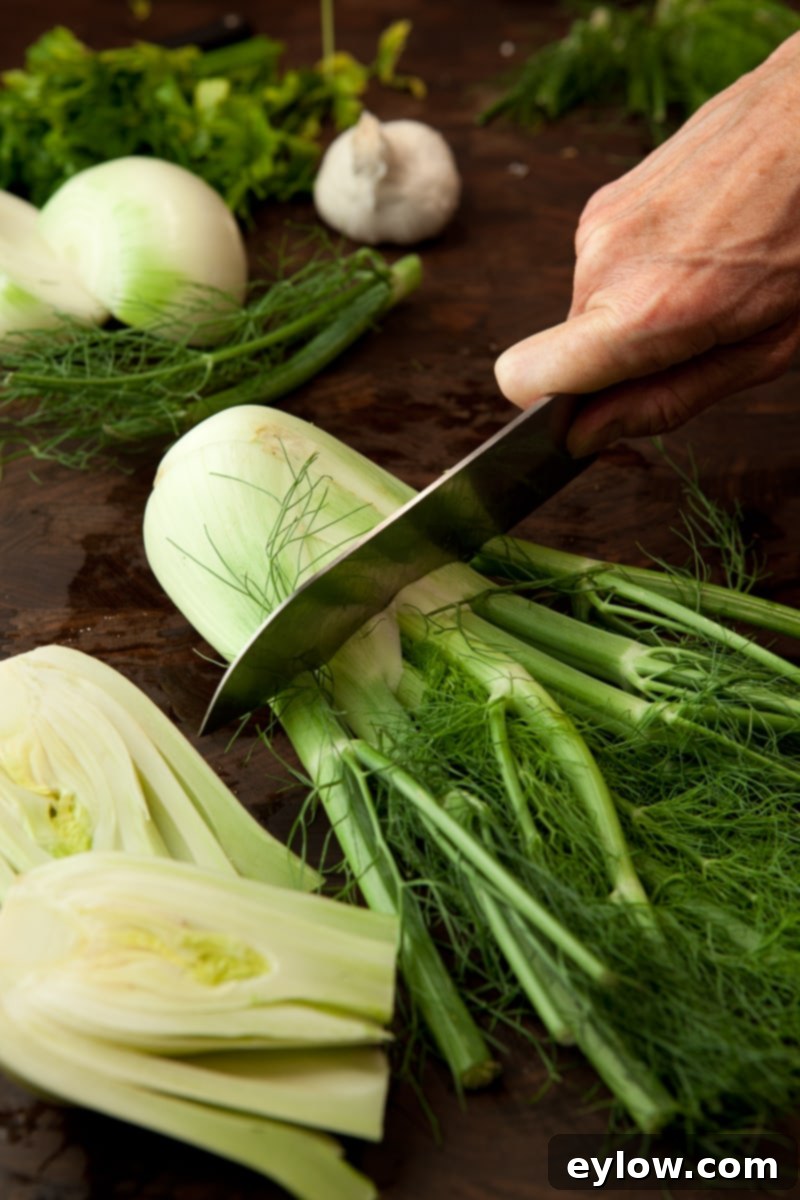
For the leeks, you’ll only use the white and light green portions, as the darker green parts can be tough and fibrous. Slice the leek in half lengthwise and rinse it thoroughly under cold running water, fanning out the layers to ensure all sand and dirt are removed. Leeks are notorious for trapping grit, so be diligent. Once clean, chop them into thin, half-moon slices.
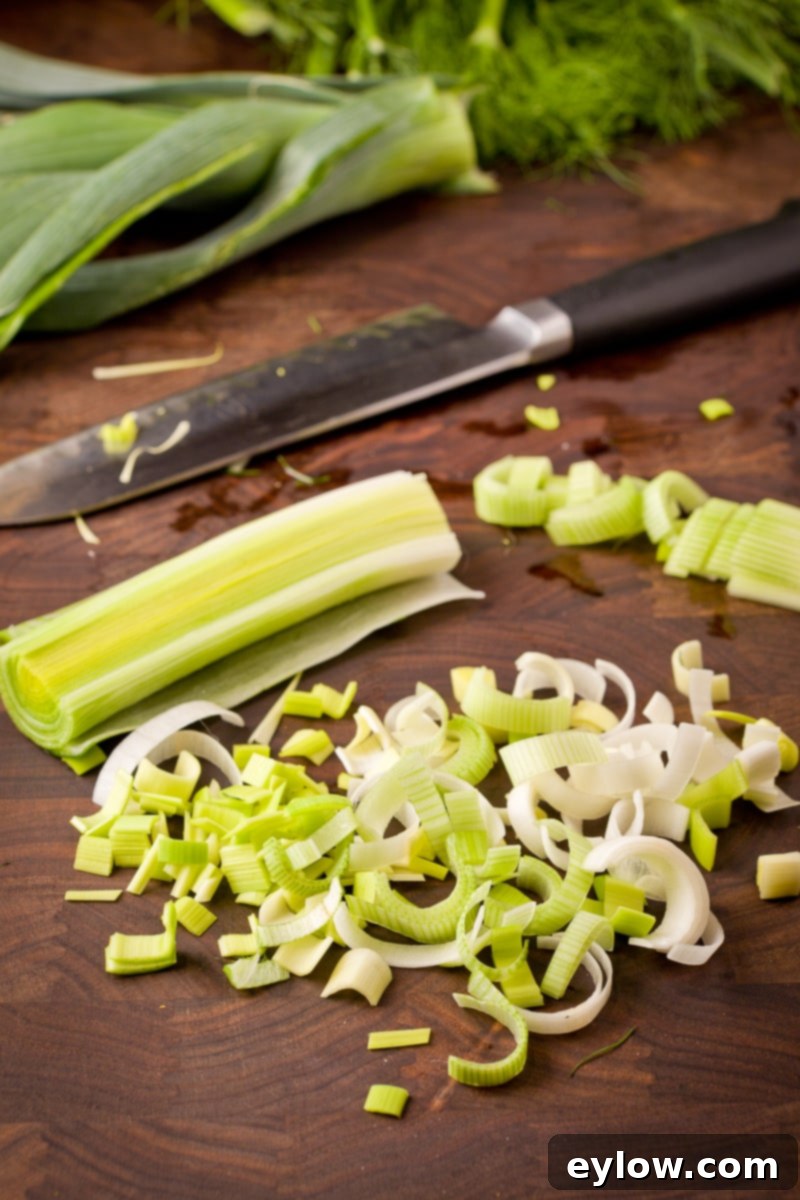
Dicing tomatoes efficiently adds both flavor and visual appeal. For a quick lesson, follow these simple steps. Begin by slicing off the top stem end of the tomato. Then, cut the tomato into quarters lengthwise. Holding your knife flat and parallel to the cutting board, carefully remove the seeds and the fleshy, watery center. This ensures your diced tomatoes are firm and not overly watery. Next, cut the quarters into long, thin strips, and then dice across these strips into small, uniform pieces. The thinner your initial strips, the finer your diced tomatoes will be. I personally prefer using Roma tomatoes for this recipe due to their firm texture and lower water content.
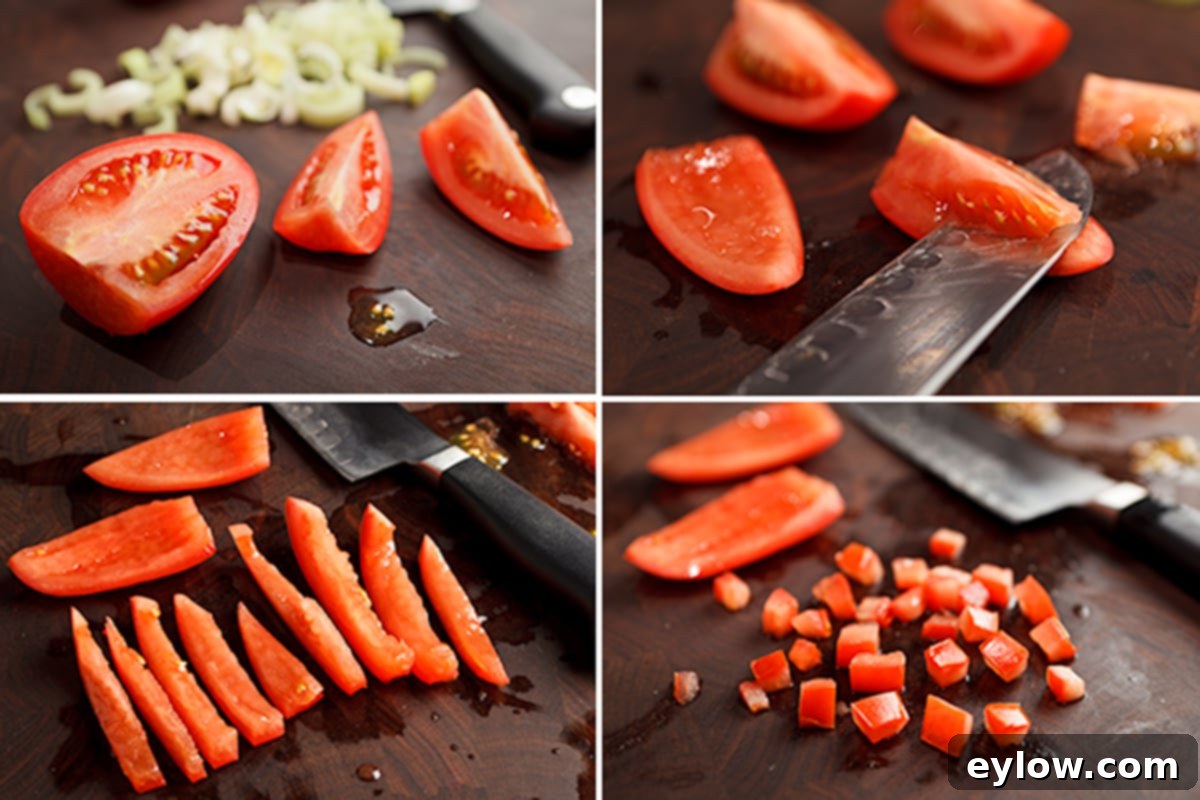
Cooking Steamed Mussels: A Quick & Flavorful Process
With all your ingredients prepped, the cooking process is incredibly fast. Begin by adding a little extra virgin olive oil to your large pot and place it over medium-low heat. Once the oil is warm, add the diced fennel and leek. Gently cook these aromatics, stirring occasionally, until they become soft and translucent, typically taking about 2-3 minutes. It’s important not to brown them, as you want their delicate flavors to shine through. Next, add the minced garlic and cook for just one minute more until fragrant. Be careful not to burn the garlic, as it can quickly become bitter.
Now, for a crucial safety step: move the pan completely off the heat. Carefully add the Pernod (if using) and the white wine. This is essential because liqueurs and alcohol have a high alcohol content and are highly flammable, especially when added to a hot pan. Once the alcohol is added, place the pan back on the heat and increase the temperature to medium. Bring the broth to a rolling boil.
Finally, add the cleaned and de-bearded mussels to the boiling broth. Immediately clamp on the tight-fitting lid, trapping the steam inside. Allow the mussels to steam for about three minutes. The steam will quickly cook the mussels and encourage them to open, releasing their delicious briny juices into the flavorful broth.
Perfectly Cooked Mussels: Knowing When They’re Ready
After the initial three minutes of steaming, quickly peek under the lid. The mussels are done when their shells have opened wide. If a majority of them have opened, replace the lid, give the pan a gentle shake, and allow them to steam for another minute. This helps any remaining closed mussels to open up. Once most of the mussels are open, turn off the heat immediately. Overcooking mussels will make them tough and rubbery, so timeliness is key.
It’s important to serve mussels immediately while they are piping hot. While you’re getting your serving bowls ready, let the pot rest with the lid on for a minute or two to retain heat. Just before serving, discard any mussels that did not open during the cooking process. Unopened mussels often indicate they were dead before cooking or contained sand, making them unsafe or unpleasant to eat.
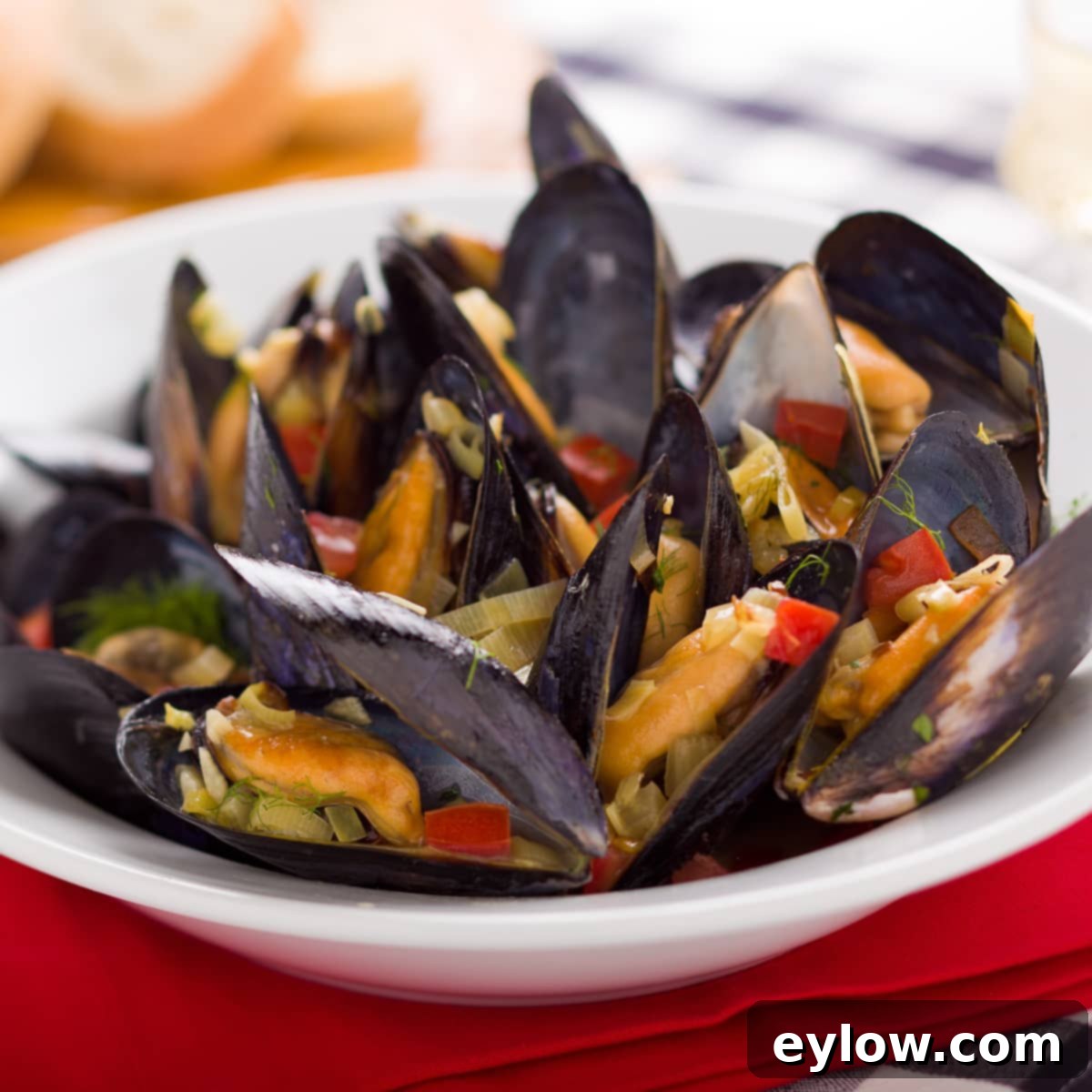
Elegant Serving Suggestions for Steamed Mussels
Steamed mussels are incredibly versatile and can be served in several delicious ways. For a classic presentation, serve them directly in warm, shallow bowls, allowing each person to enjoy the mussels and their exquisite broth. Don’t forget to distribute the wonderful juices generously over the top of the mussels – this is where much of the flavor lies! Discard any mussels that remain stubbornly closed before serving.
For a heartier meal, mussels can be served over a bed of linguine or your favorite pasta, allowing the noodles to absorb the flavorful broth. If you’re seeking a low-carb option, zucchini noodles or spiralized vegetables make an excellent substitute. To finish, sprinkle your beautiful dish with the diced tomatoes and a vibrant garnish of fresh chopped Italian parsley or the reserved fennel fronds. The fresh herbs add a burst of color and a final layer of aromatic flavor. A small loaf of crusty bread is an absolute must-have accompaniment, perfect for soaking up every last bit of that incredible broth.
More Delightful Seafood Recipes
If you’ve enjoyed this steamed mussel recipe and are looking to expand your seafood repertoire, we have more delicious options to explore. Try our comforting Linguine with Clams, perfect for a cozy evening. For a more elegant presentation, discover our recipe for seared scallops served with tender vegetables and pasta. Or, for a quick and easy weeknight meal, whip up this easy oven scampi recipe that’s bursting with lemon and garlic flavor.
📖 Recipe
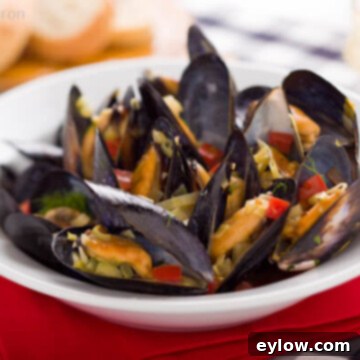
Steamed Mussels in White Wine Sauce
Sally Cameron
Pin Recipe
Equipment
-
large pot with lid
Ingredients
- 1-2 tablespoons extra virgin olive oil
- ½ small fennel bulb save fronds to chop for garnish, diced small
- ½ medium leek white and pale green parts only, thinly sliced
- 1 large garlic clove chopped fine
- 3 ounces dry white wine or 5 ounces if not using Pernod
- 2 ounces Pernod
- 2 pounds fresh live mussels scrubbed clean and de-bearded
Garnishes
- 1 Roma tomato chopped fine
- 1 tablespoon fresh chopped Italian parsley
- 1 small loaf bread to soak up the broth gluten-free or regular
Instructions
-
In a large pot, heat the olive oil over medium-low heat. Once warm, add the diced fennel and leek. Cook, stirring occasionally, until the vegetables are tender and translucent, which should take about 2 minutes. Ensure they do not brown. Add the minced garlic and continue to cook for just one minute more until it becomes fragrant.
-
Carefully remove the pan from the heat. Add the dry white wine and Pernod (if using). Return the pan to the heat and increase to medium. Bring the broth to a rolling boil. Add the cleaned and de-bearded mussels to the pot, cover tightly with a lid, and reduce the heat to medium. Steam the mussels until they have all opened, typically taking 3-5 minutes. Check the pan at the 3-minute mark. If most of the mussels are open, replace the lid, give the pan a good shake, and steam for an additional minute. Turn off the heat.
-
To serve, divide the cooked mussels evenly between two warmed bowls. Spoon the flavorful broth generously over the top of the mussels. Garnish with the finely chopped Roma tomatoes and fresh herbs (parsley or fennel fronds). Serve immediately with crusty bread to soak up all the delicious broth. Remember to discard any mussels that did not open during cooking.
